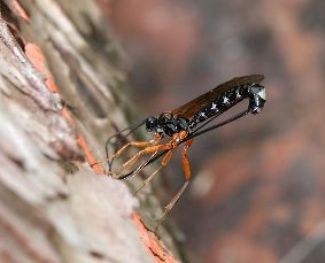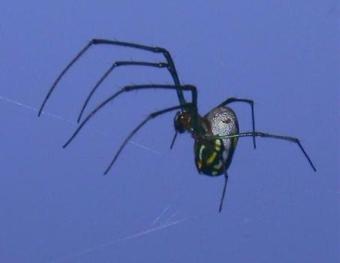Interactions
Of all the parasitic wasps currently
known to man, Hymenoepimecis argyraphaga may be one of
the most interesting and unique species due to its highly
specific means of host-prey interactions. This wasp, like all
other species of the Polysphincta group, is a koinobiont
ectoparisitoid of spiders. For the H. argyraphaga
specifically, the Plesiometa argyra is its spider host
of choice (Gauld, 2000). Let's break this description down: an
organism considered a koinobiont is a specific type of
parasitoid. This means the host in which it attacks continues to
grow and feed throughout the parasitism (Harvey et. al, 1995).
The ecto- prefix refers to the outside of something, so an
ectoparisitoid attacks the outside of its host.
H. argyraphaga actually uses the P. argyra
spider to complete its lifecycle. This parasitic wasp tends to
have a bias for mature female spiders. When approached, the male
spiders respond in a more aggressive manner and tend to chase
off the wasp attackers. Also, in one observation by Eberhard, a
male spider host failed to create the desired web needed for the
larval development (Eberhard, 2001). But once the female spider is spotted --usually
occupying its web-- the female wasp launches an attack. The
attack usually consists of the wasp connecting to the spider via
its legs through the web then continuously stabbing the spider
with her ovipositor generally on the ventral surface, but
occasionally in the mouth. Most usually, the ovipositor of the Ichneumonidae exist solely as an organ to inject/lay eggs, but,
as in this case, it can be used as an offensive weapon. While
H. argyraphaga uses visual cues to find its prey, other
Ichneumonidae use highly developed chemical sensory systems to
oviposit, as the wasp below is demonstrating. It has just
located a caterpillar beneath the wood and is lining up for the
egg deposition.

Photo courtesy of: Richard Bartz
Following the ovipositor piercing attacks, the P. argyra becomes paralyzed. This is where it gets particularly interesting: the female H. argyraphaga, now resting on the anterior surface of the spider's abdominothorax region, probes its victim (again using its ovipositor). Why does she do this? Well, since other female wasps may have already oviposited into this spider already, she seeks out other larvae that may be inside. Once/if found, the female usually tears out the developing larva oviposited by another H. argyraphaga, where it then falls to the ground. This behavior can be explained by competition, since survival and offspring production are indeed competitive processes. Clear of other larvae, the female wasp oviposits an egg of her own, gluing the oval-shaped mass on the ventral surface of the spider, then flies away. Surprisingly enough, the egg it attaches does not come from the end of its ovipositor; instead, the egg emerges from the tip of its abdomen (Eberhard, 2000). Development of the larva begins and proceeds in a most unusual manner; it is detailed here.
Although the wasp of current interest is indeed known to be a fierce and effective predator, it, surprisingly enough, has its own group of predators to be worried about. In its most vulnerable state --that of its cocoon stage-- spiders and other unknown organisms have been found to completely remove the developing insect inside the cocoon from the web in which it hangs, potentially killing it, or by simply tearing into the cocoon and undoubtedly ingesting the larva. What may appear as a one-time-only incidence was observed by Eberhard: placed in a cramped space, the P. argyra spider, recently parasitized by the H. argryaphaga larva, actually ate its attacker right off its abdomen (Eberhard, 2000).
This leads us to a spooky story...
